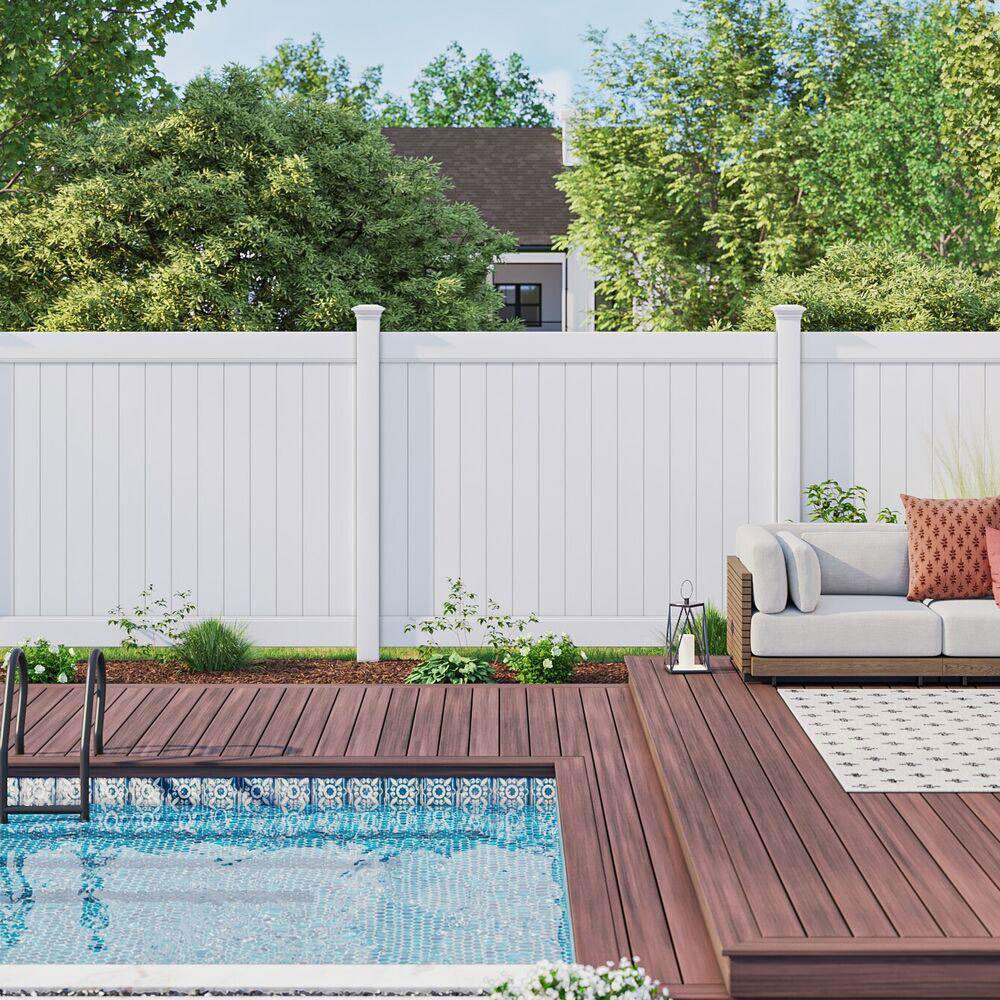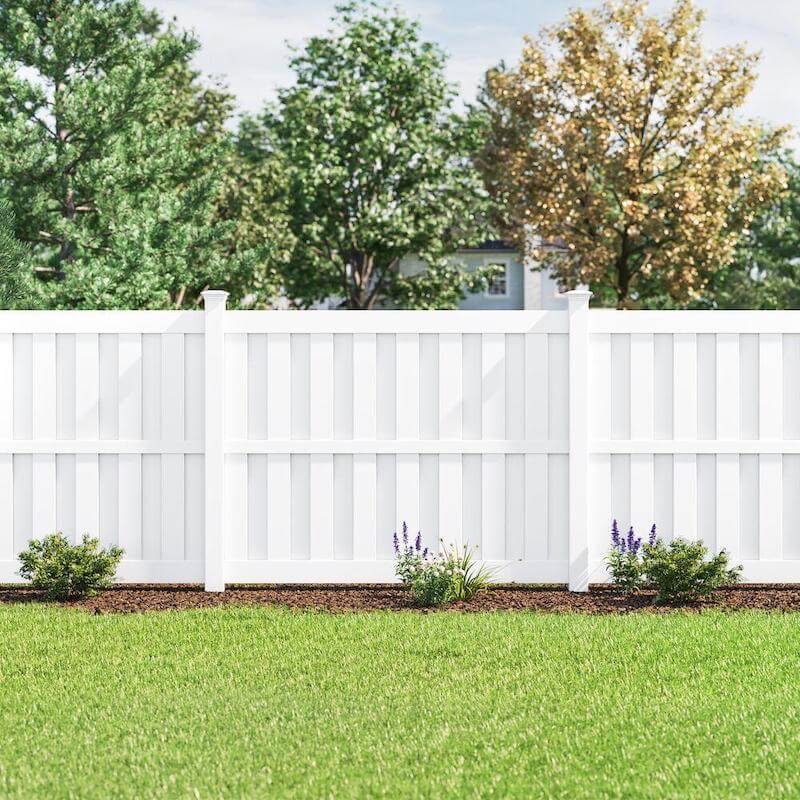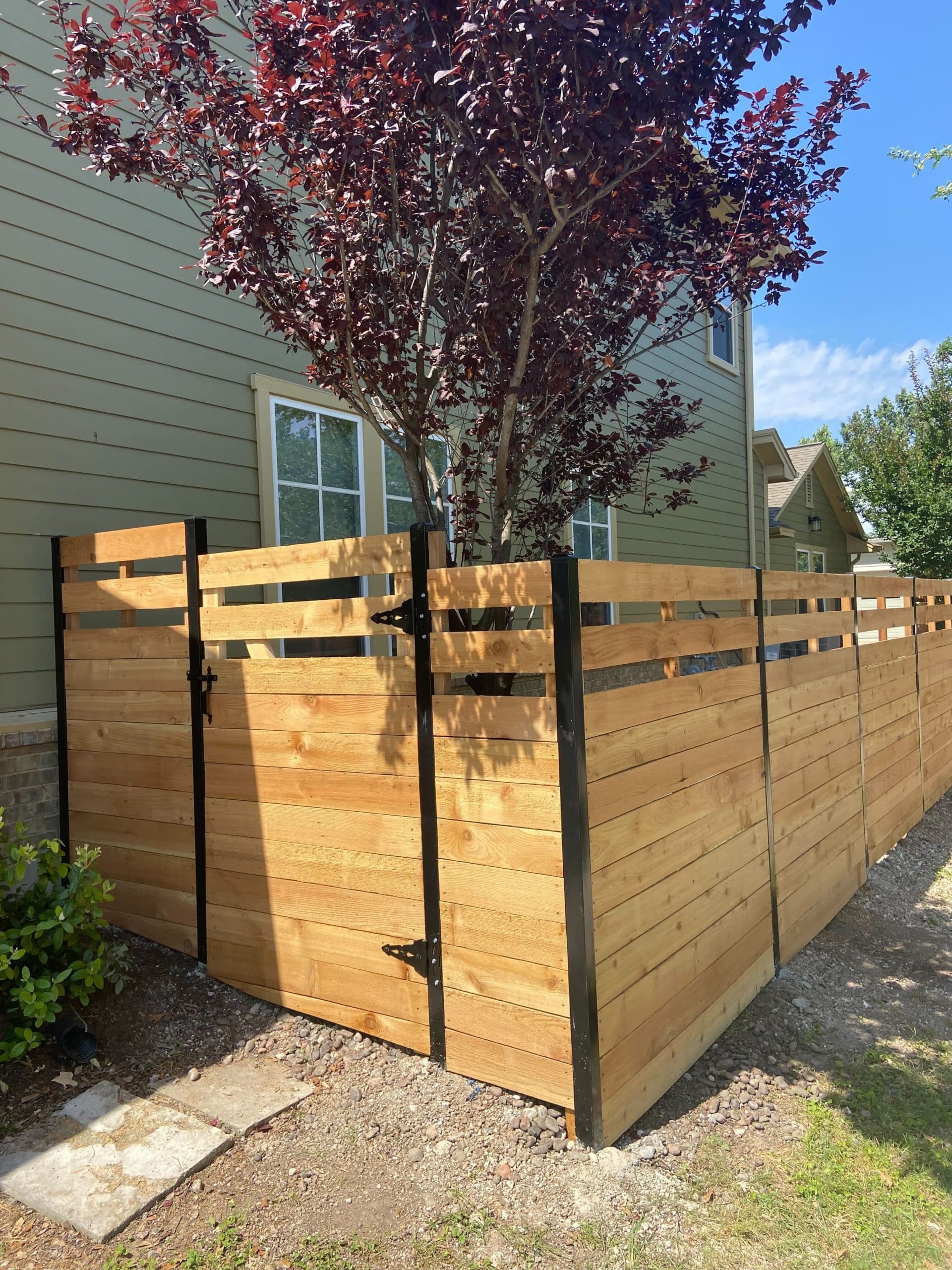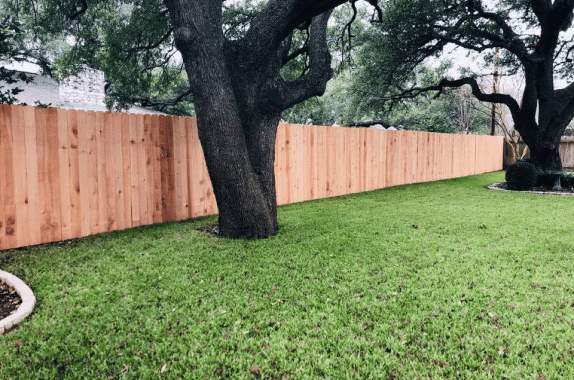28 Patio Privacy Ideas for Your Backyard in 2025
The perfect outdoor patio is inviting, relaxing, and private. While you can design a…

Wood fences are the classic choice, from the iconic white picket fence to the modern design options with organic textures and unique grains. Vinyl is presenting stiff competition, however, for its durability and low maintenance.
Made up your mind? Get an instant online free quote for a vinyl or wood fence.
Not ready? Keep on reading to decide which fence material is right for you, wood or vinyl.

Wood fences tend to be less expensive than vinyl fences. However, wood fences do require staining and other maintenance which can quickly add up.
Depending on the amount of time you plan on living in your home you should also expect to have to repair your wood fence at some point.
A vinyl fence will not require repairs unless it’s affected by a major storm or other physically traumatic event.
Vinyl costs more money upfront, but maintaining wood makes it more expensive over time. Vinyl requires virtually no maintenance, whereas wood may need repairs and restaining or painting during its lifespan to address broken, warped, or rotten boards. Vinyl typically outlasts a wood fence and resists weather damage, rot, and insects.
Vinyl won’t warp or fade, and tends to look the same as the day it was installed. All you have to do is clean it regularly. Wood may need to be cleaned, treated, sealed, and stained and re-stained over time. Wood fences need to be replaced after about 10 or 20 years.
In summary, the vinyl fence is cheaper in the long run.
To summarize, let’s provide a list of pros and cons of vinyl and wood fences:
| Vinyl | Wood | |
|---|---|---|
| Pros | Virtually maintenance free | More natural look |
| Minimal repairs | Plenty of style options | |
| Easy to clean | Cheaper upfront costs | |
| Cost effective | Refinishing and staining options | |
| Cons | More difficult to repair, if needed | High maintenance |
| More artificial look | Susceptible to weather, rot, sun damage, warping | |
| No staining or refinishing option | Harder to clean | |
| Expensive over time |
| Vinyl | Wood | |
|---|---|---|
| Maintenance and upkeep | ✓ | |
| Durability | ✓ | |
| Strength | ✓ | |
| Ease of installation | ||
| Repairs | ✓ | |
| Aesthetics | ✓ | |
| Home resale value | ✓ | |
| Sustainability | ✓ | |
| Cost | ✓ |

Vinyl fences
Vinyl fences are practically maintenance free. In fact, if you notice a layer of dust or dirt accumulating, chances are the next rain storm will wash it completely clean.
You can also keep your fence clean by power washing regularly.
Vinyl fences won’t need ongoing maintenance. They generally maintain their look over decades and aren’t susceptible to weather damage, rot, warping, or other problems that can occur with wood.
That said, vinyl fences are more difficult to repair if they’re damaged.
Wood fences
Wood fences need to be cleaned and stained, a task that can be both time consuming and pricey.
Of course with staining, it’s not a one time thing either, you will have to re-stain it every couple of years, power washing it prior to stain application.
Repairs may be needed, but it’s an opportunity to redo your fence to suit a new aesthetic for your home.
This is not an option with a vinyl fence, as you can’t stain or refinish them. Wood fences are also more difficult to clean than vinyl fences.
Maintenance and upkeep winner: Vinyl

Vinyl fences
Vinyl is a manmade product so you can expect it to last pretty much forever with proper installation.
With vinyl fencing you don’t have to worry about the weather affecting the fence and causing it to prematurely decay or rot.
Wood fences
While both fences are considered to be durable, wood fences do need regular upkeep to maintain their integrity.
As a natural product, wood will decay over time, and weather will cause it to shrink and expand.
Most wood fences will last around 10-30 years with proper treatment and preventative maintenance, but that will vary based on the wood species used.
Cedar and redwood will last the longest, but will be a little more expensive to install.
Durability winner: Vinyl

Vinyl fences
Vinyl fences are stronger than wood fences. Vinyl fencing is naturally flexible, so it won’t warp, stretch, or sag over time after exposure to strong winds that are common in Central Texas.
With the high tensile strength, vinyl fences are resistant to scratching or damage that can be caused by dogs or other pets.
The material won’t chip, crack, blister, or peel, no matter what the environment brings.
Wood fences
Wood fences look and feel sturdy, but one strong storm or a lot of high wind can damage them.
Cedar and redwood are generally structurally strong and more resistant to rot and decay, but all wood fences are susceptible to damage from weather, pests, warp, rot, sun exposure, and storms.
You need to maintain a wood fence to keep it strong as well.
Strength winner: Vinyl

Vinyl fences
Installing wood or vinyl fencing is a straightforward process. The posts are secured in the ground with concrete and the panels are attached with screws.
Vinyl posts and panels are much lighter than wood, however, and they require special brackets to attach panels to the posts. These brackets have caps that snap on to hide the hardware.
Wood fences
Contrary to common belief, the weight of wood fences isn’t a significant challenge during installation. Instead, their installation requires a more detailed approach compared to vinyl fences.
For wood fences, at Austex we use ringshank nails rather than screws, ensuring a more secure and durable construction.
Both vinyl and wood fences benefit greatly from professional fence installers to ensure their longevity and optimal performance.
Ease of installation winner: Vinyl

Vinyl fences
Vinyl fences are hollow inside rails and slats. They’re glued together, so if a slat cracks or breaks, you will need to replace the entire panel.
Vinyl fences are virtually impossible to cut or reshape as well, since this leaves the spaces open to view.
Wood fences
Wood fences are easier to repair and customize than vinyl.
While it’s not easier to cut than vinyl, you can cut and reshape wood without leaving unsightly gaps. If a part of the wood fence is damaged, you may be able to remove and replace just a few slats instead of the whole panel.
Repairs winner: Wood

Vinyl fences
Both wood and vinyl fences offer an array of styles and designs, so choosing between them is a matter of preference. Both offer privacy options as well.
While vinyl fences do come in various designs, your choices will be dependent on the manufacturer; if you want a unique fence a wood fence might be the best option for your yard.
Vinyl can’t be re-stained or painted, so the color you choose will be the color you have for the life of the fence. That said, vinyl has a clean, classic look that works for virtually any aesthetic.
Wood fences
Wood fences give you a few more customization options – you can select from a horizontal wood fence, a lattice wood fence, or a classic wood privacy fence just to name a few.
If you want to change the look of your fence before the end of its lifespan, you can paint or stain it for a new look. This isn’t an option for vinyl. Wood fences also have a more natural and rugged look than vinyl.
Aesthetics winner: Personal preference

Vinyl fences
Vinyl fences have higher upfront costs and virtually no maintenance, but they don’t look as elegant as a wood fence.
If they are well installed, attractive, and add benefits like security or privacy, vinyl fences can improve the resale value of your home for the right buyer.
Wood fences
Wood fences are more natural looking and appealing, but they do require maintenance.
Overall, wood fences are better for increasing your home’s resale value, but it depends on what local buyers are looking for and what benefits the fence offers, such as privacy and security.
Home resale value winner: Wood

Wood fences
Wood is more sustainable than vinyl. As a natural material, wood doesn’t negatively impact the environment and can be recycled once the fence reaches the end of its lifespan.
The main types of wood used for fencing are grown in a number sufficient to meet the demand in the US as well, so there’s no environmental impact to using natural wood.
Vinyl fences
Vinyl is generally less sustainable than wood. As a man made material, vinyl has a less eco-conscious manufacturing process and may leach chemicals into the environment.
However, the ActiveYards vinyl fences that we offer at Austex are non-toxic and recyclable, so they’re as sustainable as wood.
Sustainability winner: Tie
While we can’t make your selection between the two fences options for you, we hope this blog post has been helpful in making your decision a little easier.
No matter which fencing option you select, your decision to work with Austex for all of your fencing needs is the right one. Give us a call today for a consultation!